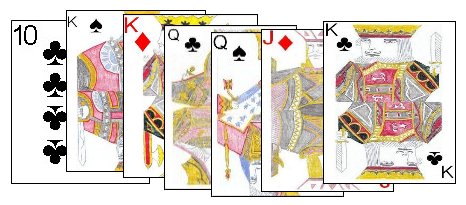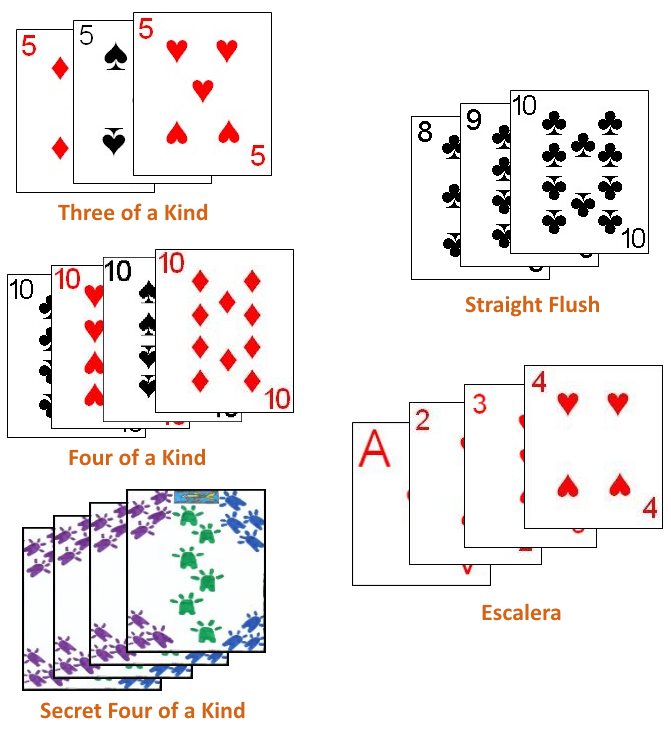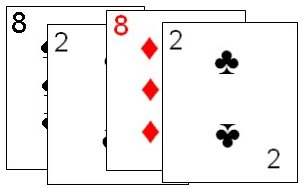How to Play Conquian (Coon Can) |
 Conquian is the oldest known game of the Rummy family which is still commonly played. While many card experts disagree on the specific nomenclature of the game and the way it has changed over time, most agree that it (at least the currently played version) hails from Mexico and is still very popular there. Many also believe that another common name for this game, Coon Can, is derived from a
mispronunciation by non-Spanish speakers of the games original name Conquian. The game is also known by several other names including Con Quien and CoonCan. This game is also thought to be related to Panguingue.
Conquian is the oldest known game of the Rummy family which is still commonly played. While many card experts disagree on the specific nomenclature of the game and the way it has changed over time, most agree that it (at least the currently played version) hails from Mexico and is still very popular there. Many also believe that another common name for this game, Coon Can, is derived from a
mispronunciation by non-Spanish speakers of the games original name Conquian. The game is also known by several other names including Con Quien and CoonCan. This game is also thought to be related to Panguingue.
 The allowable melds (called spreads) in Conquian are as follows:
The allowable melds (called spreads) in Conquian are as follows:
| Trivia: Tonk was such a popular game amongst Jazz great Duke Ellington and his sidemen, it inspired him and fellow songwriter Billy Strayhorn to create a song with the same name, Tonk. |
 After looking at the cards and before the first player has his first turn, any player may declare a "Tonk". A player may do this if he has, in his initially dealt hand, no card lower than a Jack. However a player must make the call of "Tonk" before any player has had his first turn. Any player that, in this situation, legally calls Tonk is instantly declared the winner of the game (the hand is not played out). If game points are being recorded, a player who wins in this way is said to win two game points for each other participant in the game. If multiple players call Tonk, the game is considered a draw and no player wins the hand, with the cards thrown in and the next dealer in turn shuffling and dealing the next game.
After looking at the cards and before the first player has his first turn, any player may declare a "Tonk". A player may do this if he has, in his initially dealt hand, no card lower than a Jack. However a player must make the call of "Tonk" before any player has had his first turn. Any player that, in this situation, legally calls Tonk is instantly declared the winner of the game (the hand is not played out). If game points are being recorded, a player who wins in this way is said to win two game points for each other participant in the game. If multiple players call Tonk, the game is considered a draw and no player wins the hand, with the cards thrown in and the next dealer in turn shuffling and dealing the next game.
| Card | Point Value |
|---|---|
| 2 - 10 | Value marked on face of card |
| King, Queen, Jack | 10 |
| Ace | 1 |
 After the draw, the player may then opt to make any melds as willing and able. Melds in this game (called a Bahay) are special combinations of cards a player can create with his cards and will play to the center of the table. The following are the allowable Bahay types in Tong-Its:
After the draw, the player may then opt to make any melds as willing and able. Melds in this game (called a Bahay) are special combinations of cards a player can create with his cards and will play to the center of the table. The following are the allowable Bahay types in Tong-Its:
| Card | Point Value in Hand |
|---|---|
| Ace | 1 |
| 2, 3, 4, 5, 6, 7, 8, 9, 19 | Value Marked on Card |
| Jack, Queen, King | 10 |

|
 If any player, before or immediately after (but before any player has had his first turn) receiving the passed card, notices that he has any of the instant win criteria he must announce this and will immediately win the hand with no play being necessary for the current hand. When declaring this the player with the instant win hand must also place the hand face up on the table in front of themselves for verification. The following lists these instant win hands:
If any player, before or immediately after (but before any player has had his first turn) receiving the passed card, notices that he has any of the instant win criteria he must announce this and will immediately win the hand with no play being necessary for the current hand. When declaring this the player with the instant win hand must also place the hand face up on the table in front of themselves for verification. The following lists these instant win hands: